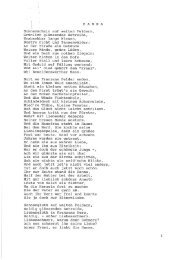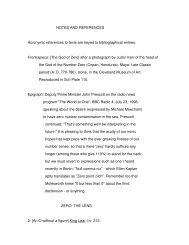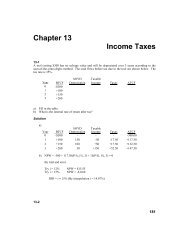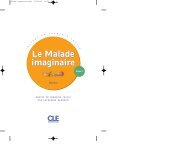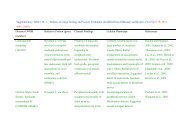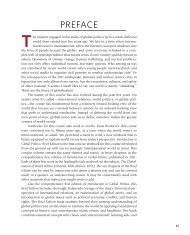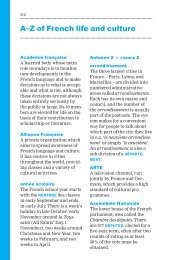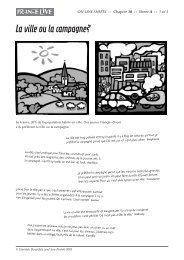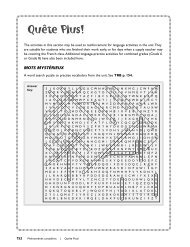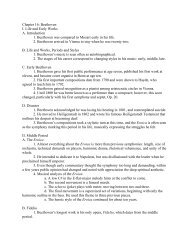CHAPTER 3 Consumer Preferences and Choice
CHAPTER 3 Consumer Preferences and Choice
CHAPTER 3 Consumer Preferences and Choice
Create successful ePaper yourself
Turn your PDF publications into a flip-book with our unique Google optimized e-Paper software.
03-Salvatore-Chap03.qxd 08-08-2008 12:41 PM Page 81<br />
Theory of<br />
revealed<br />
preference The<br />
theory that<br />
postulates that a<br />
consumer’s<br />
indifference<br />
curve can be<br />
derived from the<br />
consumer’s<br />
market behavior.<br />
<strong>CHAPTER</strong> 3 <strong>Consumer</strong> <strong>Preferences</strong> <strong>and</strong> <strong>Choice</strong> 81<br />
The fact that the marginal utility approach gives the same result as the indifference<br />
curve approach (i.e., 2X <strong>and</strong> 6Y) should not be surprising. In fact, we can easily show why<br />
this is so. By cross multiplication in equation [3.6], we get<br />
MUX<br />
MUY<br />
= PX<br />
PY<br />
[3.7]<br />
But we have shown in Section 3.2 that MRSXY = MUX/MUY (see equation [3.2]) <strong>and</strong> in<br />
Section 3.5 that MRSXY = PX/PY when the consumer maximizes utility (see equation<br />
[3.5]). Therefore, combining equations [3.2], [3.5], <strong>and</strong> [3.7], we can express the condition<br />
for consumer utility maximization as<br />
MRSXY = MUX<br />
MUY<br />
= PX<br />
PY<br />
[3.8]<br />
Thus, the condition for consumer utility maximization with the marginal utility approach<br />
(i.e., equation [3.6]) is equivalent to that with the indifference curve approach (equation [3.5]),<br />
except for corner solutions. With both approaches, the value of equation [3.8] is 2.<br />
AT THE FRONTIER<br />
The Theory of Revealed Preference<br />
U<br />
ntil now we have assumed that indifference curves are derived by asking the consumer<br />
to choose between various market baskets or combinations of commodities.<br />
Not only is this difficult <strong>and</strong> time consuming to do, but we also cannot be sure that<br />
consumers can or will provide trustworthy answers to direct questions about their preferences.<br />
According to the theory of revealed preference (developed by Paul Samuelson<br />
<strong>and</strong> John Hicks), a consumer’s indifference curves can be derived from observing the<br />
actual market behavior of the consumer <strong>and</strong> without any need to inquire directly about<br />
preferences. For example, if a consumer purchases basket A rather than basket B, even<br />
though A is not cheaper than B, we can infer that the consumer prefers A to B.<br />
The theory of revealed preference rests on the following assumptions:<br />
1. The tastes of the consumer do not change over the period of the analysis.<br />
2. The consumer’s tastes are consistent, so that if the consumer purchases basket<br />
A rather than basket B, the consumer will never prefer B to A.<br />
3. The consumer’s tastes are transitive, so that if the consumer prefers A to B<br />
<strong>and</strong> B to C, the consumer will prefer A to C.<br />
4. The consumer can be induced to purchase any basket of commodities if its<br />
price is lowered sufficiently.<br />
Figure 3.12 shows how a consumer’s indifference curve can be derived by<br />
revealed preference. Suppose that the consumer is observed to be at point A on budget<br />
line NN in the left panel. In this case, the consumer prefers A to any point on or below<br />
NN. On the other h<strong>and</strong>, points above <strong>and</strong> to the right of A are superior to A since they<br />
involve more of commodity X <strong>and</strong> commodity Y. Thus, the consumer’s indifference<br />
curve must be tangent to budget line NN at point A <strong>and</strong> be above NN everywhere else.<br />
Continued . . .



